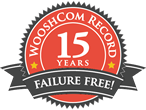Optimizing Fiber Interconnects to carry MPEG Video
To request our white paper on capacity planning in ASI to Gig-E aggregation please submit a request using our White Paper Request Form. This paper introduces WooshCom's proprietary Fixed Rate Null Packet Filtering technology. Your fiber interconnects may be unnecessarily carrying MPEG NULL packets and thereby wasting anywhere from 20% to 50% of its capacity on these filler packets.

MPEG Null Packets
When carrying MPEG-2 or MPEG-4 video via MPEG-2 Transport Streams, something called Null Packets are regularly inserted by encoders and distribution systems. These Null Packets are inserted for many reasons and sometimes for no reason at all. One reason they are inserted is to pad-up variable bit rate content so as to produce a constant bit rate transport stream.
What is an MPEG Null Packet? It is a regular sized MPEG transport stream packet of 188 bytes in length with a few header bits set so to indicate that the contents of the remaining 184 bytes is meaningless.
Where Null Packets Originate
Many Satellite receivers which are transporting multiplexes of several programs, will turn the programs which are not selected for decryption into Null packets by flipping the appropriate header bits in these packets. This can have the effect of producing a stream where the desired video is just a trickle amidst a deluge of Null packet data.
In a typical scenario, a 3.75Mbps standard definition (SD) stream flows from a Satellite receiver amidst either 54 Mbps or 155 Mbps of data, the majority of which is MPEG Null packets. In the 54 Mbps case, 93% of the capacity can be saved using WooshCom's MPA-1212 Null Packet Filter. This represents a 14 to 1 reduction in capacity requirements.
The current trend is to convert these transport streams into IP data as close to the receiver as possible. With newer satellite receivers this is done internally even before the signal leaves the device over a Gig-E port. This encapsulation of MPEG into UDP/IP packets has two important effects:
- these meaningless Null packets are effectively "cast in stone" as they become IP packets and
- they become hidden inside valid UDP/IP packets which must then be transported across the network.
Optimizing Fiber Usage
There are several approaches which can be taken to optimizing the bandwidth usage of Fiber. Which one can be employed depends of the system architecture being used and the point at which content is being ingested.
Architecture 1) Remote Site Multiplex Formation
In the case where the chosen distribution architecture is to formulate the final MPEG multiplexes at remote sites as shown in the Remote Muxing Diagram, MPEG content may be distributed across the fiber without any Null packets present. This provides optimal bandwidth usage of the fiber. If any of the content is variable bit rate (VBR) in nature the MPEG remultiplexers at the remote sites can typically accept them and repackage them into constant bit rate (CBR) transport stream mutiplexes.
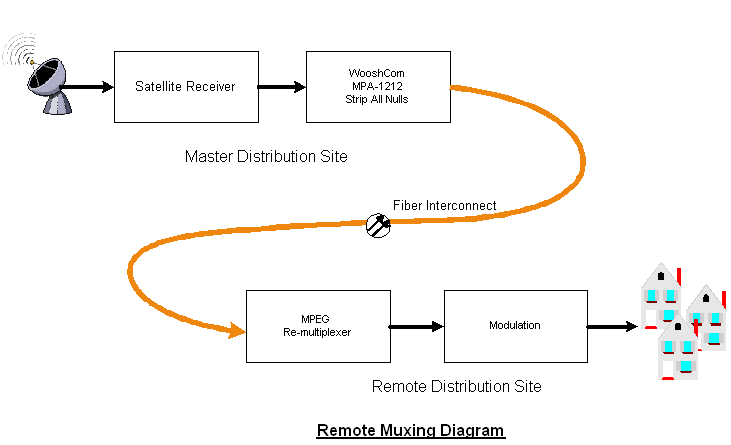
In this mode WooshCom's Null Packet Filter, the MPA-1212, is set so as to strip out all Null packets thereby producing a stream with only packets containing useful information. The resulting transport stream will posses the same rate properties as the underlying elementary stream or streams. If they are VBR in nature then the resulting transport stream will also be VBR in nature. However if the underlying streams are all CBR in nature then the overall transport stream will also be CBR.
Architecture 2) Central Site Multiplex Formation
In the case where MPEG multiplexes are formed at a central master site as shown in the Central Muxing Diagram, once again MPEG Null Packets may be distributed across the fiber with all Null packets removed, but the stream must be reformed into a CBR stream at the remote site. This is easily accomplished using WooshCom's MPA-1212 in its Null padding mode.
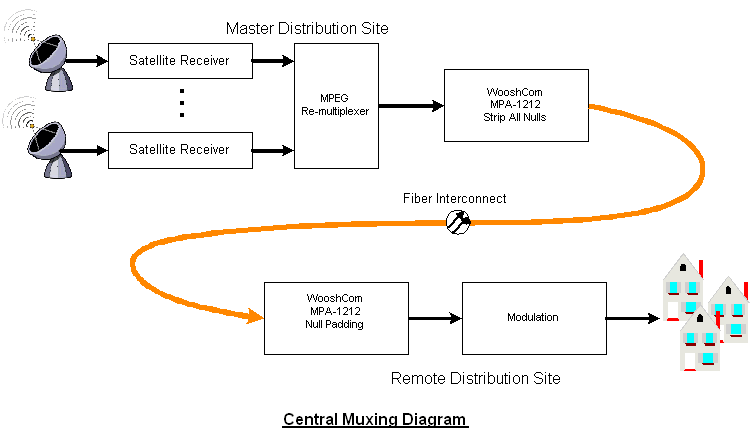
In the Null padding mode the MPA-1212 reinserts Null packets so as to formulate a CBR transport stream of the desired rate. 128 pre-selected rates between 70 Kbps and 213.7 Mbps are pre-programmed into the MPA-1212. The net result is a CBR transport stream with a rate that is tailored to the requirements of the modulator.
Architecture 3) Remote Content Ingest
In many cases content must be ingested at a remote location and fed onto a centralized fiber backbone for distribution. In this case, once again, the best approach depends on whether the content will later be combined into a multiplex with other programs or not. In either case the fiber bandwidth can most likely be reduced by using the MPA-1212 to remove or reduce the number of Null packets.
In the case where the content is fed back to a central master facility for multiplexing, all the Null packets may be stripped out by an MPA-1212 as shown in Remote Ingest to Central Mux Site Diagram. This reduces fiber bandwidth usage to an absolute minimum.
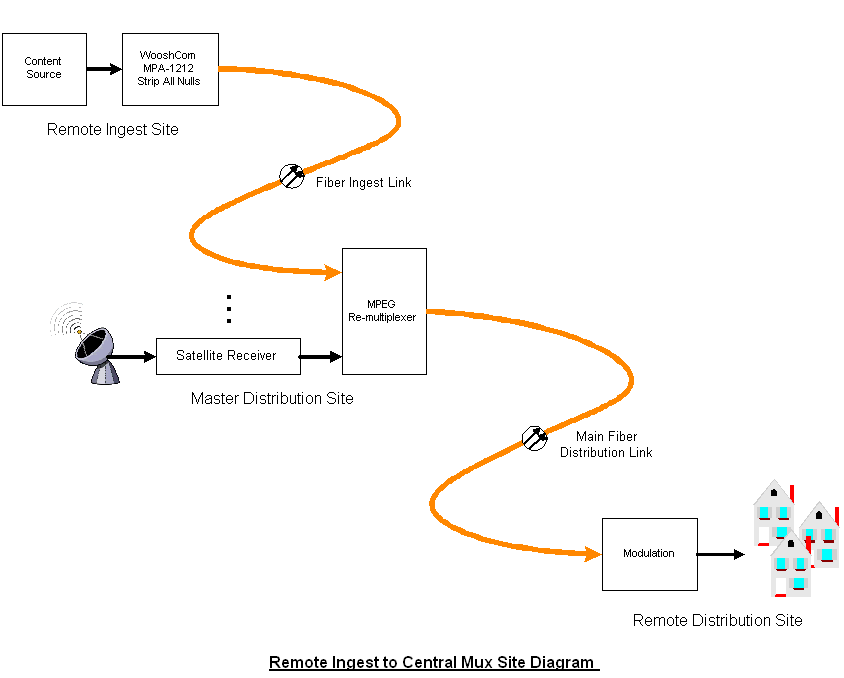
In the case where the remotely ingested content is to be fed directly onto a fiber for direct distribution to peer sites, an MPA-1212 may be used as shown in Remote Ingest to Peer Sites Diagram to remove un-necessary Null packets and formulate an optimal CBR stream.
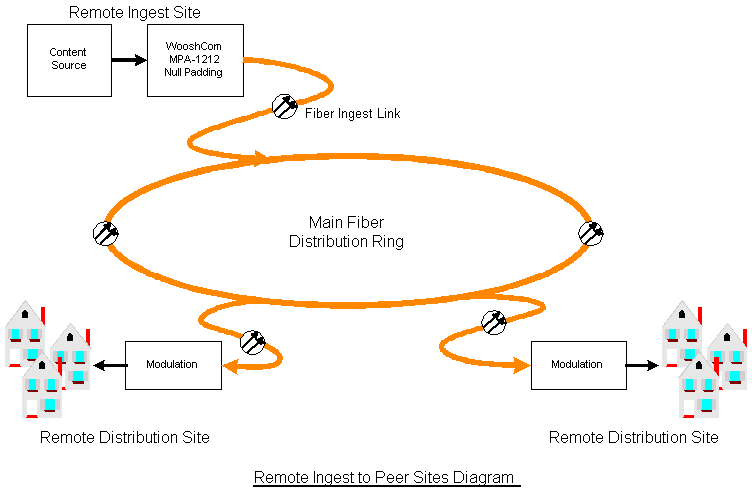
Alternately further bandwidth improvement may be achieved as shown in Alternate Remote Ingest to Peer Sites Diagram, by removing all Null packet at the remote Ingest Site and then re-formulating the stream into a CBR at each remote site using the MPA-1212 in Null Padding mode.
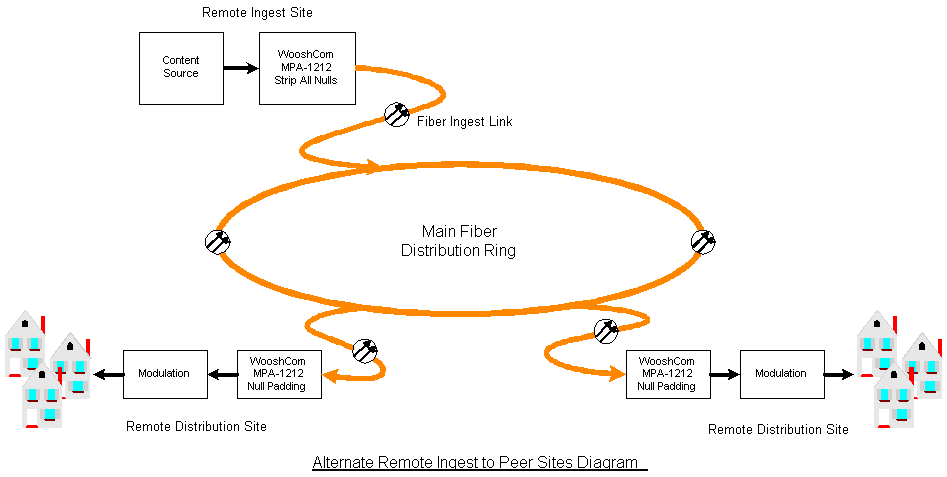
Conclusion
WooshCom's MPA-1212, Null Packet Filter, with its dual modes of Null Packet Stripping and Null Packet Padding provides a very handy and flexible tool to optimize bandwidth usage when MPEG Video is being distributed via fiber. Furthermore, the single channel nature of the MPA-1212 provides great flexibility and scalability in deployment. It may be easily deployed at remote sites where only one or two channels are needing to be processed or at central sites where it would need to be scaled up to scrub many channels.
